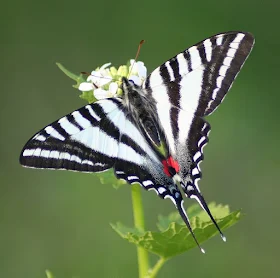June 29: 8 miles
July 2: 10 miles
July 3: 5 miles
July 4: 7 miles
July 5: 10 miles
Total of 40 out of 65 miles desired.
Michigan Swallowtails
 | ||
| Larval foods: Birch, aspen, Prunus serotina, Malus | |
 |
| Larval foods: Many, including Cow Parsnip and Northern Prickly Ash |
 |
| Larval foods: Many including Prunus serotina, Ash, Cottonwood, Wafer Ash |
 |
| Larval foods: Spicebush, Sassafrass, Redbay, Camphor tree |
 |
| Larval foods: Citrus, Prickly Ash, Wafer Ash, rue |
 | |
| Zebra Swallowtail. Larval foods: Pawpaw tree leaves. |
Locally, Northern Prickly Ash is common but not dominant in any particular location. Leaves smell like lemons.
Wafer Ash is uncommon locally but easy to see and grows well from seeds. Leaves seem to be immune to mildews and molds.
Spicebush is occasionally found in rich, bottom-lands that is forested.
Sassafrass is common in dry, sandy soils and seems to be a prime target of Japanese beetles.
Pawpaw thickets are often associated with locations of former Native American villages. They thrive in bottom-lands.
Swallowtails are enormous butterflies. Some of them have 7-1/2" wingspans. Many of their larval food sources are resistant to browsing by Whitetail deer, perhaps due to the toxins that make the caterpillars unpalatable to most predators.
Beautiful to see. Thx.
ReplyDeleteGreat progress - and thanks for the butterfly pictures. Such beauty is always a good reminder we do live in a pretty amazing world.
ReplyDeleteThe creek behind me (Greasy run, named after a local bear that would get into your garbage if you put any grease in it), is positively loaded w/ pawpaws. I've made pancakes and muffins with them. A nice treat (sub for bananas in any recipe).... never seen one if those types of butterfly's, however. I'll have to keep an eye out.
ReplyDeleteLook around milkweed and dogbane when they are in bloom.
DeleteThe adults feed on nectar.
When I bought my house about five years ago, there was a mystery plant sprouting from the base of an old oak in the backyard. I thought it might be a peach or maybe a pear based on the leaf shape, but last year it flowered and I figured out it was a pawpaw. I was really excited to try the fruit since I've never had it, but the raccoons got them. There are more of them ripening right now so maybe I'll get a second chance this year. The fruit don't keep well whole, but the pulp freezes well; I'm envisioning pawpaw ice cream or creme brûlée.
DeleteAfter five years of planting food-bearing trees and shrubs, benign neglect of the "lawn," and the addition of many pollinator plants, this year has seen an amazing efflorescence of life. A mystery citrus in the dooryard was crawling with swallowtails this year. Their caterpillars look exactly like fresh bird turds, which is pretty clever mimicry.
Since I work at a golf course and also play golf three times a week, I average about 2 1/2 miles a day. ( I ride a cart when playing, but you still have to do quite a bit of walking.) I did a little over 3 miles today.
ReplyDeleteI like the butterfly photos. I have some flower seeds to plant that are supposed to attract them. Right now is the perfect time to plant them. And my Snowball Hydrangea is starting to bloom.
Have you tried 2 - 5 pound ankle weights with an 8 - 12 pound weight vest to increase your walking workout intensity and reduce its duration? One or two pound hand weights are another intensity booster.
ReplyDelete